Razer Blade 14-Inch Gaming Notebook Review
by Dustin Sklavos on July 2, 2013 1:00 PM ESTSystem and Futuremark Performance
Despite being remarkably slim, the Razer Blade 14-inch is afforded remarkable capacity for performance thanks to its well-designed cooling system. The result is that despite fitting squarely in Intel's ultrabook category, there's a tremendous amount of horsepower on tap. Razer benefits from advances in Intel's Haswell design by employing the 37W Core i7-4702HQ, a quad-core processor which moves the chipset on package. Meanwhile, they can leverage the increased parallelism of an NVIDIA GK106 (as opposed to GK107 in the last generation of Blades) without substantially higher thermals.
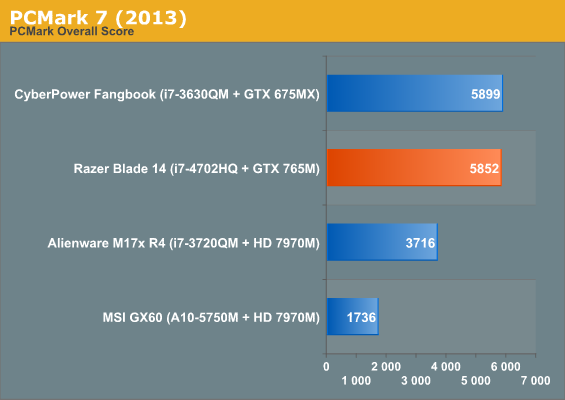
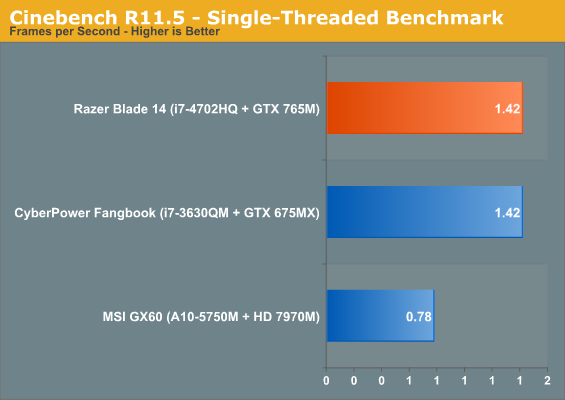

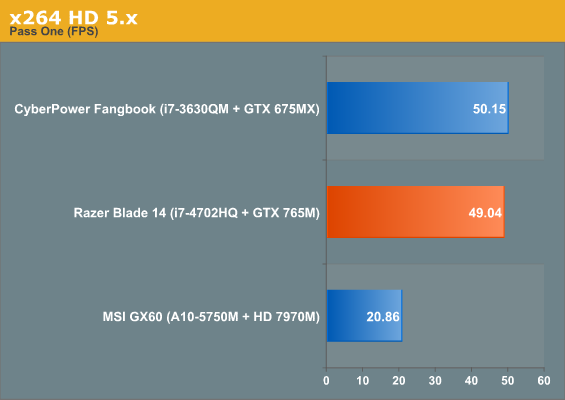

Just how fast is the Blade 14? Fast enough. The i7-4702HQ is able to meet the last generation i7-3630QM's performance without much issue, and ensures that CPU bottlenecks won't be much of an issue during gaming sessions.
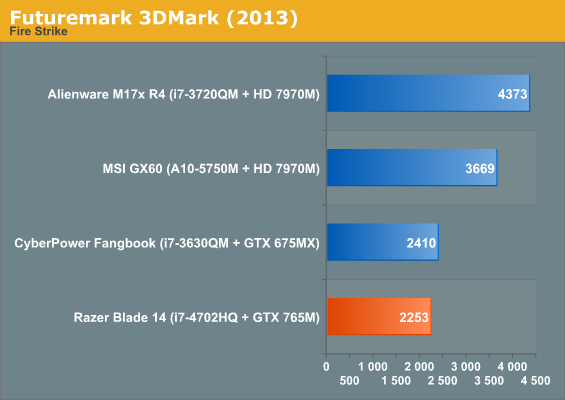

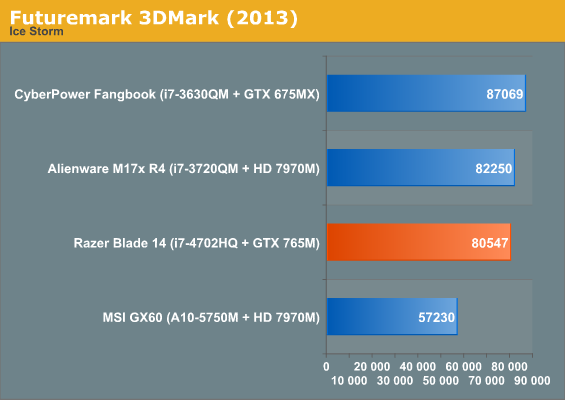
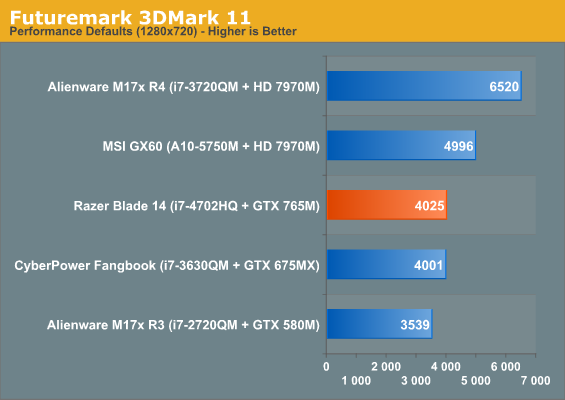
The Razer Blade 14-inch isn't knocking it out of the park in 3DMark, but it doesn't need to. What's impressive is how close it is to the GeForce GTX 675MX; that chip is a full GK106 with 960 CUDA cores and a 256-bit wide memory bus, but the substantially higher clocks on the GTX 765M help make up the difference. What you're going to see as we move forward is that the 765M is actually hampered only by its 128-bit memory bus; shader power is largely present for this chip, and the 1600x900 panel resolution in the Blade 14-inch may actually be the sweet spot for performance.










108 Comments
View All Comments
robco - Tuesday, July 2, 2013 - link
If they're going to crib from Apple, they need to go all the way. I don't want to hear any criticism about how Apple lacks ports or requires adapters. Not even ac wireless? With a rMBP, I could use a gig-E network adapter. My other primary concern is the intake vents on the bottom, since I do often use my laptop in my lap.I agree that this laptop has a lot going for it. But the display is very important. I don't see why they went cheap. Granted, Razer may not have Apple's R&D resources, but they don't have to write their own OS either.
Check101 - Tuesday, July 2, 2013 - link
Ah, thank you for the clarification. This confirms my thoughts... The notebook manages heat by pushing the heat away from the user, and it is slim, powerful, sturdy, and has a large battery. Now, some hard numbers show that this screen is terrible for this price-point. I was very curious about an upcoming review ever since Razer CEO posted a review of the 14 inch Blade on his Facebook page arguing that the screen was just fine, but that was a very quick review that glossed over important details. Now we know... Razer needs another iteration of this notebook...arthur449 - Tuesday, July 2, 2013 - link
Great review, Dustin. I enjoyed your attention to detail about the notebook's hot spots and remarks about the usability of the keyboard. You're also spot-on about Razer hitting the sweet spot in terms of notebook gaming hardware.While the screen is hilariously bad, how're its response times? It seems completely odd to me that they would've neglected this aspect of the overall package so badly. Maybe they sacrificed viewing angles, contrast, and color quality in favor of a bright twitchy TN panel gamers on-the-go would appreciate in poorly lit areas? I'm assuming it's not a 120Hz panel, but does it have any notable ghosting?
dwade123 - Tuesday, July 2, 2013 - link
It already struggles with the latest console ports. Next-gen ones are gonna make this an obsolete device.Silma - Tuesday, July 2, 2013 - link
It looks nice enough but unfortunately it follows the tradition of too many notebook makers of marrying a decent/good cpu/gpu pair with as many crappy parts as possible. Yet again, as for the Carbon X1, an indecent super baSilma - Tuesday, July 2, 2013 - link
super bad super low res screen.This, combined with no Ethernet network, and the wariness with Razer's lack of quality control that came with the purchases of too many premium mouses that won't work more than a few months at the most, will make it easy for to admire the notebook's aesthetics
from afar and buy something else, probably the Asus Infinity or the Samsung 9+ if they ever step out of vaporware.
SpartanJet - Tuesday, July 2, 2013 - link
Will you be reviewing the Razer Blade Pro this time around?wdfmph - Tuesday, July 2, 2013 - link
Last time I said gaming laptop does not make sense and lots of people shoot me. See it yourself. It just has to drop the ball here or there no matter how expensive they could be. Last time is the stupid single fan design in the MSI laptop, this time is the miserable screen.In addition, I think reliability of RAZER products questionable.
Winterblade - Tuesday, July 2, 2013 - link
Great review... hopefully the next version will correct the display quality, I'm perfectly fine with the resolution but if indeed windows 8.1 can fix the way windows manages high-density displays then I would definetly want a more dense display.Also, please Razer add a gigabit ethernet port or at least bundle the next generation blade with an adapter, this is a gaming machine, not a god-damn tablet.
I'm all in for a truly portable gaming machine, and at this very moment I consider this the very best option in that regard (NO, I will not carry more than 2Kg half-way trough the world, nobody should :P), that being said, with 2 horrible faults (display & ethernet) I just can't justify my self buying the blade, fix at least one of these and count me onboard for Gen2 Blade 14.
Roland00Address - Tuesday, July 2, 2013 - link
Dustin before you send back the Razer or resell it can you by chance test the integrated graphics for the intel hd4600. We got benchmarks for the desktop 4600 (but that has a much higher tdp so it can always hit those boost clocks), and we saw how thermally limited the intel 5000 was compared to the intel 4400 with the macbook air and acer s7.It would be nice to know how the non ulv intel hd graphics will perform in mainstream notebooks, and how this will compare to trinity/richland.